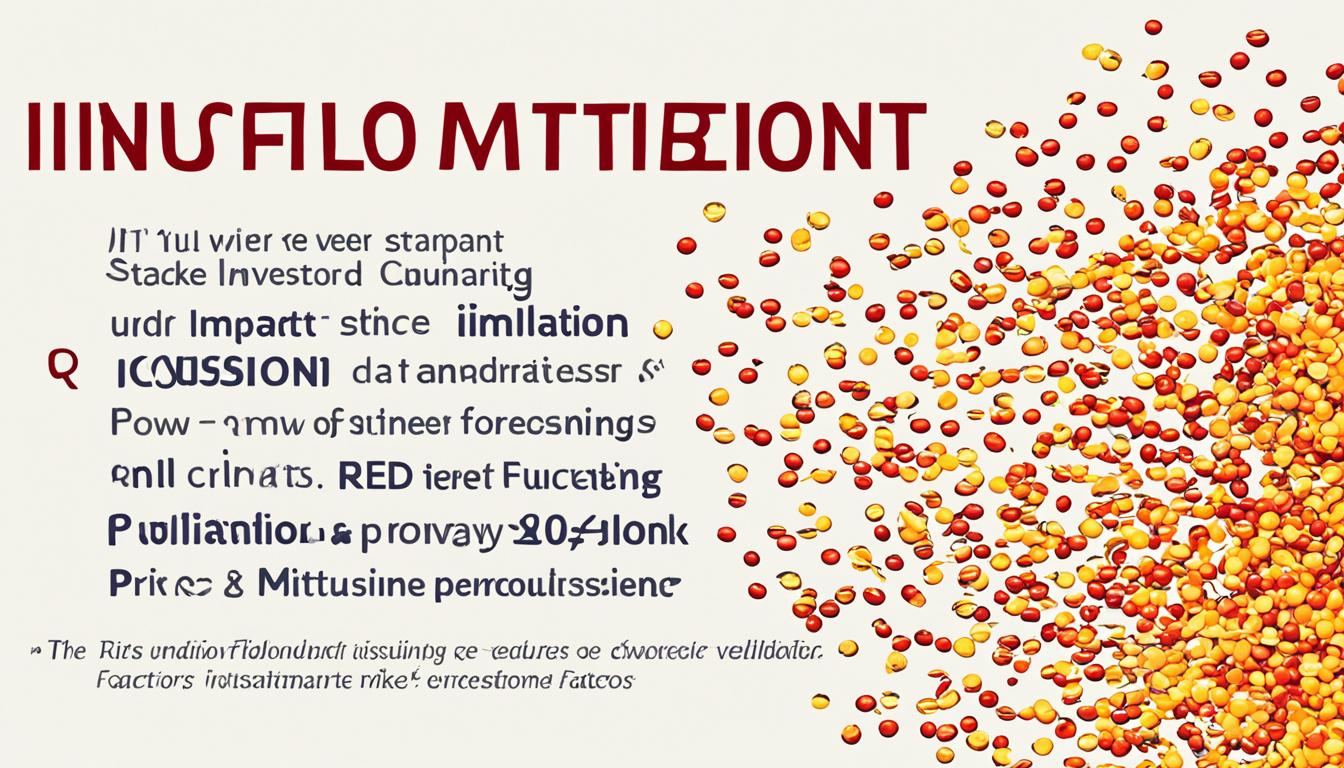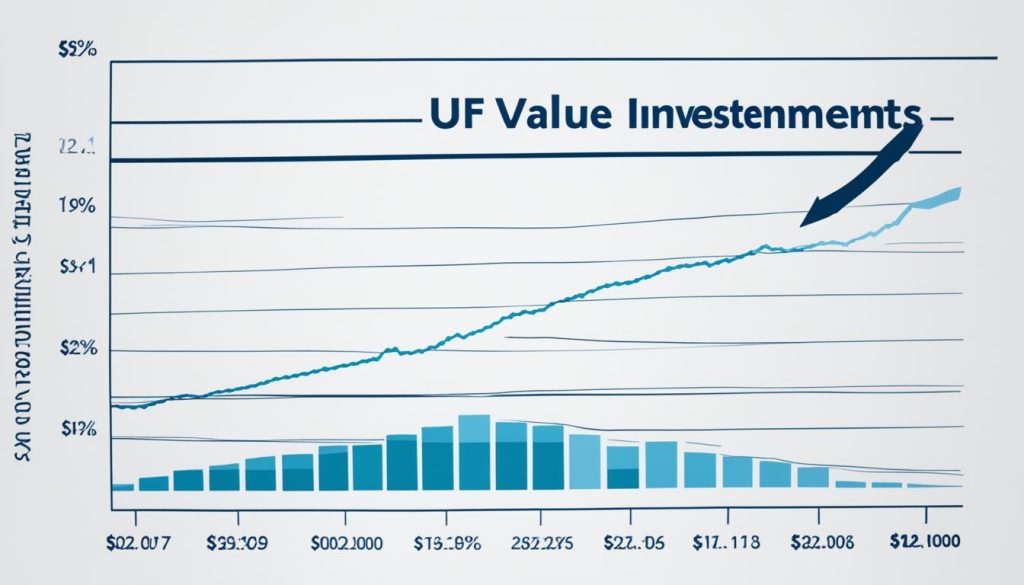Inflation can really cut down on how much you can buy with your money. It also makes investments worth less over time. When the Federal Reserve changes interest rates to fight inflation, it can make markets more unpredictable.
Looking at data from the Bureau of Labor Statistics and the Federal Reserve shows how inflation and investments are linked. It’s key to know this to handle your investments well in times of inflation.
Key Takeaways
- Inflation reduces the purchasing power of money, hence affecting investment value.
- Federal Reserve’s interest rate changes are a common tool to combat inflation but can result in market volatility.
- Historical data shows varying impacts of inflation on different types of investments.
- Managing investments in inflationary periods requires strategic adjustments and awareness.
- A thorough understanding of inflation risks is crucial for investment success.
The effect of inflation on different types of investments
Inflation can deeply affect various investments, changing how well portfolios perform. It’s key for investors to grasp these effects to manage their money well in inflationary times.
Fixed-income investments like bonds are hit hard by inflation. When inflation goes up, the value of the fixed interest payments drops. This means investors see their real returns shrink. Past data shows that bond yields often don’t match inflation, which can cut into investors’ earnings.
Equities might help protect against inflation but come with their own risks. Looking at the S&P 500 shows how stocks can adjust for inflation over time, even if it’s bumpy. Companies might increase prices to keep profits, but this approach isn’t risk-free.
Real estate can be strong during inflation because it’s a real asset. Reports show property values often go up when prices do, helping protect against inflation. Rent income can also keep pace with inflation, giving real estate investors a steady income.
| Investment Type | Inflation Effect | Additional Insights |
|---|---|---|
| Bonds | Negative | Susceptible to reduced purchasing power of interest payments |
| Equities | Mixed | Potential hedge, but with increased market volatility |
| Real Estate | Positive | Tangible asset, may rise in value with inflation |
In conclusion, inflation affects investments differently based on the asset type. Investors should think about these differences to lower risks and improve their portfolios during inflation.
Inflation risks and their impact on investment performance
It’s key to know how inflation risks affect investments for smart investment plans. Inflation risk means the rising cost of living could cut into investment gains. This risk changes a lot over time.
Understanding inflation risk
Inflation risk in investments means your money’s value drops over time. This is bad news for fixed-income investments like bonds. Their returns don’t keep up with rising prices, leading to a loss in value when adjusted for inflation.
Historical perspectives on inflation and investment returns
Looking back at times of high inflation, like the 1970s and early 1980s, shows how it hits investments. High inflation led to unstable markets and lower returns. The Consumer Price Index (CPI) went up a lot, affecting investments.
| Time Period | Inflation Rate (CPI) | Stock Market Performance | Bond Market Performance |
|---|---|---|---|
| 1970s | Above 6% | Variable, often negative | Negative (losses) |
| 1980s | Moderate, briefly high | Recovery in stock market | Improved as inflation cooled |
| 2000s | Low inflation (around 2%) | Stable, positive returns | Bond markets steady |
On the flip side, the 2000s saw low inflation, making investments more predictable. This led to good returns in stocks and bonds. Data from the CPI and investment records shows these differences clearly. This helps investors understand inflation risks better.
Managing investments in high-inflation environments
When dealing with high inflation, it’s crucial to have a solid plan for your investments. Knowing the good and bad of different methods can help investors make smart choices.
Active versus passive investment strategies
Active strategies mean making quick decisions to take advantage of market trends. These methods can lead to big gains but need constant attention. On the flip side, passive strategies follow long-term trends and are cheaper but might not work well during inflation.
Looking at the results, active management can beat passive in times of high inflation.
Sector-specific strategies
Some sectors do better than others when inflation is high. Commodities and energy sectors usually gain value as prices go up, helping investors keep their wealth safe. But, sectors like consumer discretionary might lose out as people spend less.
Reports on commodities and energy show these areas can be strong against inflation.
Inflation-protected securities
Securities like TIPS and Series I savings bonds are made to fight inflation. TIPS adjust their principal to match inflation, keeping your investment safe. Series I bonds mix a fixed rate with an inflation adjustment, offering a solid defense against inflation.
According to the U.S. Treasury, these bonds are key for keeping your money’s value steady during inflation.
The impact of inflation on investments
Knowing how inflation affects investments is key for both individuals and big financial groups. Inflation changes how much money can buy, affecting the value of future earnings. It’s also important for companies that work across the globe, as they face different inflation rates in each market.
In the short term, inflation can lower the real value of some investments. For example, bonds might lose value because their future payments are worth less now. But, the long-term effects depend on how investments handle inflation. Stocks can sometimes protect against inflation if companies raise prices to cover their costs.
Investor feelings play a big part in how the market moves. If many think inflation will keep going, markets can get more unstable. Big financial firms like J.P. Morgan and Goldman Sachs often talk about how investor feelings affect investments during inflation. Studies show that inflation impacts not just local investments but also those that invest worldwide.
| Investment Type | Short-term Impact | Long-term Impact |
|---|---|---|
| Fixed-income Securities | Negative | Negative |
| Equities | Varies | Positive |
| Real Estate | Neutral | Positive |
| Commodities | Positive | Positive |
Experts say that when inflation hits, investors often move to real estate and commodities. This shows why it’s vital to grasp both the immediate and lasting effects of inflation on investment performance.
Investment strategies for inflation protection
In today’s changing economy, knowing how to protect your investments from inflation is key. By looking at investment strategies for inflation protection, you can keep your money safe. This means focusing on inflation-adjusted investment returns and spreading your investments out.
Inflation-Adjusted Returns
To get inflation-adjusted returns, you need to pick investments that grow in value or pay income that keeps up with inflation. Treasury Inflation-Protected Securities (TIPS) are a good choice because they increase in value with inflation. Real estate and precious metals like gold and silver are also good because they keep their value over time.
Effective Portfolio Diversification
Spreading your investments out is key to fighting inflation. By investing in different types of assets, industries, and places, you can lessen the blow of inflation. Things like certain commodities and cryptocurrencies can also help protect your money.
It’s important to know how different investments relate to inflation. Studies show that some investments, like stocks in certain sectors, can do well when prices go up.
- Consider Treasury Inflation-Protected Securities (TIPS) for reliable returns.
- Evaluate real estate and precious metals as hedges against inflation.
- Explore cryptocurrencies and other alternative assets for diversification.
By using these investment strategies for inflation and focusing on assets that keep up with inflation, you can make your investments stronger. This way, you’ll be ready for inflation and can keep your money safe.
Conclusion
Understanding how inflation affects investments is key for anyone looking to grow their money. This article has shown how different investments handle inflation in different ways. It’s important to look closely at each type of investment.
Investment strategies for fighting inflation vary widely. Options include managed portfolios, sector-specific plans, or securities that protect against inflation. Being smart and strategic is crucial. History tells us that those who adjust their plans well in high-inflation times often do better.
Staying up-to-date with economic trends through trusted sources is vital. Reading about successful investment strategies and getting advice from experts can help a lot. By learning and making smart changes, investors can handle inflation and protect their financial future.
FAQ
What is the impact of inflation on investments?
Inflation can reduce the value of money and investments. When inflation is high, interest rates might go up. This can make markets more unstable. The Bureau of Labor Statistics shows how inflation changes prices and affects investments.
How does inflation affect different types of investments?
Bonds can be hurt by inflation because their interest payments might not keep up with rising costs. Stocks might offer some protection against inflation but come with risks. Real estate can be more stable because it’s a physical asset, especially during inflation.
What is inflation risk in investments?
Inflation risk means an investment’s value could drop due to rising prices. The 1970s and early 1980s showed how inflation can hurt investments. Data from the Consumer Price Index and investment records highlight this risk.
How can investors manage investments during high-inflation environments?
Investors can use active or passive strategies to handle high inflation. Active strategies might include changing how assets are allocated and using hedges. Passive strategies focus on long-term trends. Commodities and energy sectors usually do well in inflation, but consumer discretionary sectors may not.
Investments like TIPS and Series I savings bonds are made to fight inflation, as reported by the U.S. Treasury.
What are some investment strategies for inflation protection?
To beat inflation, look for investments that grow in real value or offer income that keeps up with inflation. Diversifying your portfolio is key, spreading out across different types of assets and areas. Assets like precious metals or cryptocurrencies can help protect against inflation. Historical data and research offer insights into these strategies.






